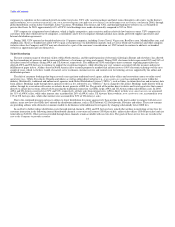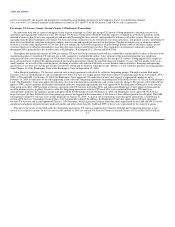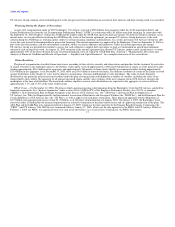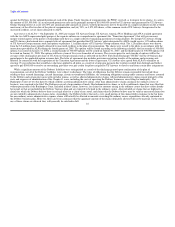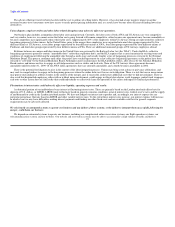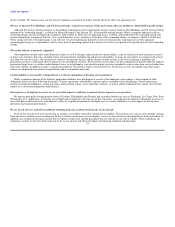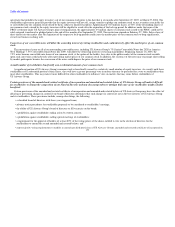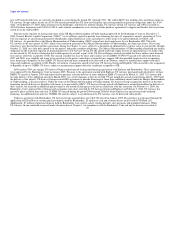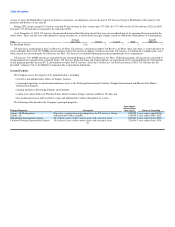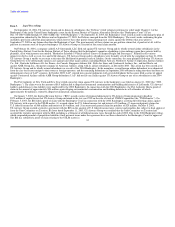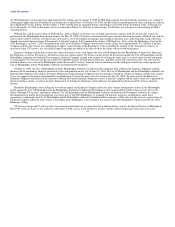US Airways 2005 Annual Report Download - page 29
Download and view the complete annual report
Please find page 29 of the 2005 US Airways annual report below. You can navigate through the pages in the report by either clicking on the pages listed below, or by using the keyword search tool below to find specific information within the annual report.
Table of Contents
not be available. We cannot assure you that laws or regulations enacted in the future will not adversely affect our operating costs.
The use of America West Holdings' and US Airways Group's respective pre-merger NOLs and certain other tax attributes is limited following the merger.
Although US Airways Group continues as the publicly traded parent entity following the merger, each of America West Holdings and US Airways Group
underwent an "ownership change," as defined in Internal Revenue Code Section 382, in connection with the merger. When a company undergoes such an
ownership change, Section 382 limits the company's future ability to utilize any net operating losses, or NOLs, generated before the ownership change and
certain subsequently recognized "built-in" losses and deductions, if any, existing as of the date of the ownership change. A company's ability to utilize new
NOLs arising after the ownership change is not affected. An ownership change generally occurs if certain persons or groups increase their aggregate
ownership percentage in a corporation's stock by more than 50 percentage points in the shorter of any three-year period or the period since the last ownership
change.
The airline industry is intensely competitive.
Our competitors include other major domestic airlines as well as foreign, regional and new entrant airlines, some of which have more financial resources
or lower cost structures than ours, and other forms of transportation, including rail and private automobiles. In many of our markets we compete with at least
one other low-cost air carrier. Our revenues are sensitive to numerous factors, and the actions of other carriers in the areas of pricing, scheduling and
promotions can have a substantial adverse impact on overall industry revenues. These factors may become even more significant in periods when the industry
experiences large losses, as airlines under financial stress, or in bankruptcy, may institute pricing structures intended to achieve near-term survival rather than
long-term viability. In addition, because a significant portion of US Airways' traffic is short-haul travel, US Airways is more susceptible than other major
airlines to competition from surface transportation such as automobiles and trains.
Certain liabilities were not fully extinguished as a result of confirmation of the plan of reorganization.
While a significant amount of the Debtors' prepetition liabilities were discharged as a result of the bankruptcy proceedings, a large number of their
obligations remain in effect following the merger. Various agreements and liabilities remain in place, including secured financings, aircraft agreements,
certain environmental liabilities, certain grievances with our labor unions, leases and other contracts, as well as allowed administrative claims, that will still
subject us to substantial obligations and liabilities.
Interruptions or disruptions in service at one of our hub airports could have a material adverse impact on our operations.
We operate principally through primary hubs in Charlotte, Philadelphia and Phoenix and secondary hubs/focus cities in Pittsburgh, Las Vegas, New York,
Washington, D.C. and Boston. A majority of our flights either originate or fly into one of these locations. A significant interruption or disruption in service at
one of our hubs could result in the cancellation or delay of a significant portion of our flights and, as a result, could have a severe impact on our business,
operations and financial performance.
We are at risk of losses and adverse publicity stemming from any accident involving any of our aircraft.
If one of our aircraft were to be involved in an accident, we could be exposed to significant tort liability. The insurance we carry to cover damages arising
from any future accidents may be inadequate. In the event that our insurance is not adequate, we may be forced to bear substantial losses from an accident. In
addition, any accident involving an aircraft that we operate could create a public perception that our aircraft are not safe or reliable, which could harm our
reputation, result in air travelers being reluctant to fly on our aircraft and adversely impact our financial condition and operations.
23



